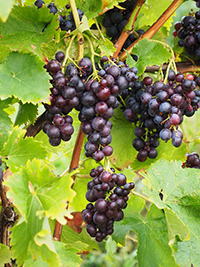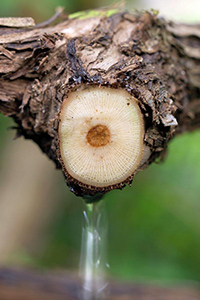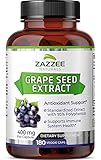Table of Contents
About 3000 cultivated species of Vitis vinifera (common grape vine) worldwide produce the fruit with the most medicinal properties known. All ancient civilizations of the Mediterranean knew of Vitis vinifera and used it comprehensively.

The fruits—grapes—and the leaves and sap of this noble plant possess many medicinal properties and are excellent natural foods/medicines that lack toxicity. We cannot say the same about wine, a product of grape juice, which, in this process of decomposition, loses its unique medicinal properties and becomes a liquid drug that can intoxicate to provoke behavior alterations and addictions.
Grape juice is rich in substances with high biological value: sugar with high nutritional value, protein, vitamins, and minerals. On the other hand, wine loses most of its sugar, which becomes alcohol during fermentation, as well as its vitamins and protein. Grape juice is a food and medicine. Wine, the product of its fermentation, lacks any nutrients. Due to its alcoholic content, it is irritant for digestive organs, and especially for the liver, even in small amounts.
Remember that the ethyl alcohol that wine contains (60-120 g per liter) is a potent poison for our body. When the blood contains one gram of alcohol per liter, it produces symptoms of ethyl intoxication (euphoria, loss of mental control, and decreasing reflexes). A level of 4-5 g per liter can cause death due to coma and respiratory failure. Maximum alcohol levels (the concentration of alcohol in the blood) allowed in Western countries for drivers vary from 0.5 to 0.8 g per liter.
Despite praise from gourmets and poets, the only property of wine tested and proven is its antiseptic effect when externally applied to wounds. This effect is due to the degree of alcohol it contains.
- 3rd Party Lab Tested: No Foreign Substances, No Fillers, Herb ID Confirmed for Your Safety, Micro test
- 100% Natural Products: No Artificial Colors or Flavors, No Sugar or Sweeteners Added
- Tested and Verified for Purity: Steam Distilled, Pristine Quality, Gluten-Free, No Preservatives, Soy-Free, Dairy-Free, Egg-Free, Cruelty-Free
In ancient times, wine was used as an antiseptic, and Dioscorides recommended it. This is the use Jesus referred to in the Parable of the Good Samaritan. Ancient myths that wine makes “good blood” or “good for the heart” have been proven wrong by scientific research, just as research has with other plants employed in ancient treatments. Consumption causes megaloblastic anemia and myocardiopathy (degeneration of the heart muscle).
Medicinal properties lie in the grapes, and the grapevine leaves in their natural condition, not in wine. We advise against the consumption of wine even when employed as a dissolving agent or vehicle for certain medicinal herbs since some patients may suffer from side effects that result in more severe consequences than the diseases they suffered from before. Therefore, authentic wine is pure grape juice.

Vitis Vinifera Scientific Facts
- French: Vigne.
- Spanish: Vid.
- Environment: Vitis vinifera is native to Asia Minor and widely spread throughout the Mediterranean countries, where wild plants can still be found (Lambrusco). At present, it is cultivated worldwide.
- Description: Vitis vinifera is a climbing shrub of the Vitaceae family. Its small flowers grow in composed clusters. The fruit, grapes, are black or greenish berries containing one to four woody seeds.
- Parts of the plant used medicinally: The leaves, the sap, the berries (grapes), and the seeds.
Healing Properties and Uses

The LEAVES of Vitis vinifera, especially those of the red variety, contain tannin with astringent properties and abundant flavonoids and anthocyanin coloring substances, which give the plant capillary protective and hemostatic properties. It is used in the following cases:
- Venous circulatory afflictions. Hemorrhoids, chilblains, varicose veins, swollen or tired legs due to disorders of the capillary permeability. It is one of the most active herbal remedies against these afflictions. In these cases, and to enhance its effects, it is recommended to combine internal and external applications; baths with the same decoction are recommended in addition to drinking a decoction of leaves.
- Gastroenteritis, chronic diarrhea, and especially dysentery with rectal bleeding due to the astringent and antihemorrhagic properties of the Vitis vinifera.
- Hemorrhage. It is beneficial for menstrual disorders to avoid frequent bleeding and hypermenorrhea (too abundant menstruation) to normalize menstrual cycles of dysmenorrhea (irregular or painful menstruation). It stops nose bleeds when directly applied, when sniffing dried ground leaf powder, and when drinking an infusion.

The SAP of Vitis vinifera is obtained when vine shoots are cut during the spring before leaves grow. This sap vine shoots exudate has been successfully used for ages to heal skin irritation (eczema and various rashes), mainly to wash eyes when affected by eyelid inflammation, styes, conjunctivitis, and inflammation of the cornea. It can also be used as an eyedropper for preventative eye hygiene. It contains sugars, tartaric acid, tartaric salts, and other organic acids and has anti-inflammatory and wound-healing properties.

The GRAPES contain 16% sugar (glucose, levulose, and saccharose), up to 1% proteins (10 g per kg), 0.5% fats, vitamins A, B group vitamins, and vitamins C and P, mineral salts, especially potassium and iron salts, organic acids, and anthocyanin coloring substances in their rind. They have stimulating, laxative, depurative, and antianemic properties and reduce congestion. The best method to take advantage of all these virtues is undergoing a grape treatment.
Grape Treatment
Consume one to three kilograms of grapes as the only food for three days or even one week. More prolonged treatments must always be performed under medical control. If grapes are correctly digested, their skins and seeds can also be eaten after being well chewed. Grape juice, reconstructed from a boiled concentrate, can also be consumed, but it is better to drink fresh juice. Be sure that commercialized grape juices do not contain any chemical-preserving substances.
This treatment achieves a very notable depurative effect, which in standard terms is called “cleansing the blood,” which is nothing more than eliminating toxins and metabolic waste that hinder the normal function of organs and tissues. A grape treatment will reduce congestion in all digestive organs, especially the liver. Grapes contain easily assimilated sugars, and their proteins and fats have high biological value. It is thus recommended for all people wanting to enhance their health condition, especially in the following cases:

- Fatty diet (rich in animal fats).
- Arthritis and gout.
- High blood pressure.
- Excess of cholesterol in the blood.
- Kidney diseases, kidney stones, nephritis, nephrosis, and kidney insufficiency.
- Obesity. Despite the sugar they contain, the calories of grapes are below 80 per 100 grams.
- Hemorrhoids.
- Chronic liver afflictions, hepatitis, cirrhosis, portal hypertension.
- Anemia, physical exhaustion.
- Lack of performance, asthenia stress.
The SEEDS of grapes contain polyunsaturated fatty acids, which help treat excess cholesterol. These are employed in the form of oil (grapeseed oil).
How to use Vitis Vinifera
- Decoction of the leaves, with 40-50 grams per liter of water. Drink three or four cups daily before meals.
- Grape treatment has depurative aims (see above).
- Grape seed oil is consumed as any other edible oil, two to five spoonfuls daily.
- Sitz baths against hemorrhoids (see below).
- Foot baths, with the same decoction used for sitz baths (see below), are used against chilblains and to improve blood circulation.
- Powder. To stop nose bleeds, inhalation of dried leaf powder.
- Young Vitis vinifera (grapevine) shoot sap. Gather in a clean container and apply directly to the skin or eyes. It cannot be preserved; therefore, it is only used in the spring.

Sitz Bath to Treat Hemorrhoids
Prepare a sitz bath with one or two liters of the same decoction recommended for internal use. Pour the decoction liquid into a suitable bath and add enough water to cover the lower stomach. The water must be cold, as it comes from the tap.
You should take up to three baths daily, each lasting around five minutes. The venotonic properties of Vitis vinifera leaves reduce hemorrhoids’ inflammation and prevent their volume from increasing. By increasing the tone of venous walls, hemorrhoids, which are typically abnormally dilated veins, contract, and blood circulation is improved.
In the case of a hemorrhoid crisis (acute inflammation), the best results are achieved by combining the healing action of Vitis vinifera in all its forms over two or three days, which include:
- Herbal teas with the decoction of leaves.
- Sitz baths have the same decoction but are slightly more concentrated.
- Grape treatment (see above).
Footbath with Vitis Vinifera Leaves Decoction

A more beneficial effect will be achieved for venous blood circulation in feet and legs when preparing two bowls:
- One of them with a hot decoction of the Vitis vinifera leaves.
- The other one, with cold water.
Put your feet for five minutes into the container with the hot decoction, then for ten minutes in the one containing cold water. Alternate three or four times, always hot decoction first and cold water last. After this, you can have an ascending foot massage.
Frequently Asked Question
What are the main bioactive compounds in grapes, and how might they work within the body?
Polyphenols: This broad category includes essential compounds like resveratrol (found in the skin), flavonoids, and proanthocyanidins (in the seeds). These act primarily as antioxidants, combating oxidative stress associated with numerous diseases.
Fiber: Grapes have soluble and insoluble fiber, aiding digestion, gut health, and potentially lowering cholesterol.
Vitamins and minerals: While not exceptionally high in potassium, Vitamin K, Vitamin C, and more, grapes contain a wide range of nutrients.
Does the color of Vitis vinifera matter for health benefits?
Yes! Red and purple grapes have higher levels of anthocyanin antioxidants (which give them color) than green grapes. Additionally, thicker-skinned grapes often deliver more polyphenols overall.
What research supports the use of Vitis vinifera in heart health?
Studies show potential benefits like:
Blood pressure reduction: Especially in those with existing issues.
Lowering “bad” LDL cholesterol.
Improved blood flow: Linked to the polyphenol content.
Are grape-derived supplements as effective as eating whole grapes?
Not necessarily. While grape seed extract focuses on polyphenols, whole grapes provide additional fiber, vitamins, and other compounds with synergistic effects (meaning they work well together). Supplements should be considered in addition to regular fruit consumption, not as a replacement.
Can Vitis vinifera help with cognitive function?
Research is early but promising. Studies suggest polyphenols may help protect the brain, improving memory and cognition with age.
Does Vitis vinifera have anti-inflammatory properties?
Yes. Grapes’ antioxidants can help reduce chronic inflammation, contributing to many diseases. This may affect the benefits seen for heart health, joint pain, and other conditions.
Is there evidence for grape consumption in cancer prevention?
Lab and animal studies are positive, but human research is still limited. Antioxidants may reduce DNA damage that can lead to cancer, and some grape compounds may directly hinder cancer cell growth.
Are there any potential downsides to grape consumption?
Grapes are generally safe, but watch out for:
High sugar content: Diabetics should monitor their portion sizes.
Pesticide residue: Opt for organic when possible.
Drug interactions: Grapefruit is well known for impacting medication; grapes can have a more negligible but similar effect. Always consult your doctor if you are on medication.
Can wine provide the same benefits as grapes?
Somewhat. Red wine has a portion of the polyphenols found in grapes, but alcohol itself has downsides. Moderate wine consumption may have some heart health benefits, but eating the grapes directly is preferable overall.
What areas of research are currently ongoing regarding Vitis vinifera?
A lot is happening! Exciting areas include:
Potential use in diabetes management
Gut health improvements
Refined grape extracts for targeted benefits (e.g., brain health)
DISCLAIMER: All content on this website is presented solely for educational and informational objectives. Do not rely on the information provided as a replacement for advice, diagnosis, or treatment from a qualified medical expert. If you are pregnant, nursing, or have any preexisting medical concerns, talk to your doctor before using any herbal or natural medicines.
REFERENCES
- George D. Pamplona-Roger, M.D. “Encyclopedia of Medicinal Plants.” George D. Pamplona-Roger, M.D. Encyclopedia of Medicinal Plants. Ed. Francesc X. Gelabert. vols. 2 San Fernando de Henares: Editorial Safeliz, 2000. 544, 545, 546, 547. Print.[Vitis vinifera]
- Healthline: https://www.healthline.com/nutrition/grape-seed-extract-benefits
- WebMD: https://www.webmd.com/diet/health-benefits-grape-seed
- Medical News Today: https://www.medicalnewstoday.com/articles/263332
- Mount Sinai: Grape Seed https://www.mountsinai.org/health-library/herb/grape-seed
Last update on 2024-07-20 / Affiliate links / Images from Amazon Product Advertising API





